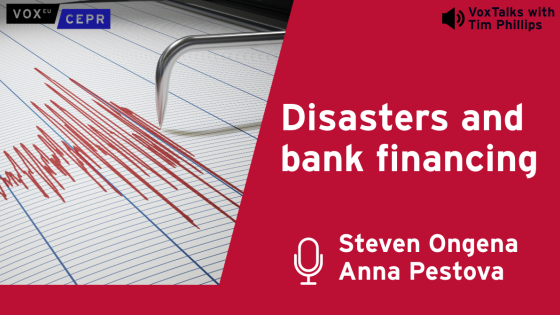Large banks with a global presence play an important role in the transmission of shocks across borders. Goldberg (2009) notes that the sheer size of foreign banking institutions and their involvement with the real economy makes them important vehicles for the global transmission of shocks. For example, foreign banks hold about 25% of the assets in the US banking system. Peek and Rosengren (2000) find that the Japanese banking crisis of the early 1990s had a substantial effect on the credit supply in the US. In a recent paper (Fillat et al. 2018), we find that after the 2010 European sovereign debt crisis, US branches of parent banks that were exposed to GIIPS sovereign debt cut their assets by 54%, representing roughly $427 billion and 8% of total US bank assets. In more recent related work, we estimate that an Italian sovereign or banking crisis in the current environment could cause a decline of as much as 20% in aggregate US bank assets.
Regulatory reforms should not only be reactive to crises, but also proactive to reduce the likelihood and limit the severity of such crises. A reform implemented in 1991 prohibited foreign branches from accepting uninsured retail deposits. Likewise, the financial crisis of 2008 and the 2010 European sovereign debt crisis prompted a wave of regulatory reforms that affected large banks in particular, including those with a global presence. For example, one of the provisions of the 2010 Dodd-Frank Act required foreign banks with more than $50 million in US subsidiary assets to consolidate all of their subsidiaries under a single bank holding company by 1 July 2016. This is known as the Intermediate Holding Company (IHC) requirement, and its goal was to mitigate the transmission of foreign shocks into the US credit markets. Incidentally, US branches owned by foreign banks were – and remain – exempt from this requirement, in the sense that assets held in branches did not count toward the $50 billion IHC threshold. As one may expect, foreign banks reacted strategically, implementing a series of changes in their operations and legal structures in response to the IHC requirements, as documented in Kreicher and McCauley (2018).
In this context, we develop a quantitative structural model of global banking that can be used to evaluate ex ante the effects of policy reforms. Our work contributes to the global banking literature in two important ways.
- First, while earlier contributions overlook the importance of a bank's mode of operations, our model provides a microfoundation for a bank's decision of whether and how to enter a foreign market – through branches or through subsidiaries.
- Second, while most studies employ reduced-form empirical analysis, our quantitative model enables us to study the cross-border effects of demand shocks and regulatory changes via comparative statics and counterfactual analysis, respectively.
A model of multinational banking
The model is designed to describe the institutional details of the banking industry and to be consistent with a number of stylised facts from US bank-level data. For this reason, our analysis focuses on the aforementioned two most significant forms of foreign banking institutions in the US: branches and subsidiaries. Current US banking regulations treat a foreign-owned branch differently from a foreign-owned subsidiary, allowing one to undertake activities from which the other is prohibited. For example, while subsidiaries are separately capitalised and can accept all types of deposits, branches are subject to capital requirements at the parent-bank level and can accept only uninsured wholesaledeposits. Moreover, branches can freely transfer funds to and from their parent, while subsidiaries have access to a limited internal capital market.
To study the extent of shock transmission, we analyse how US-based affiliates of European banks responded to the European sovereign debt crisis. We find that, in the wake of the crisis, US branches of exposed European banks saw a flight of their uninsured deposits, while deposits at subsidiaries (both insured and uninsured) grew. Because intrafirm transfers of funds from their parents only partially offset the shortage of funding, the US branches of exposed European banks experienced a large decrease in their assets. At the same time, assets increased slightly in exposed US subsidiaries. These facts inform the construction of our model.
The bank's problem is modelled as a monopolistically competitive extension of the Monti-Klein model (see Klein 1971 and Monti 1972), augmented to include institutional features such as capital requirements and deposit insurance. The model explicitly distinguishes among foreign banking institutions by their choice of operational structure, which is endogenous and responds to differences in the regulatory environment and in bank management efficiency. This feature allows us to assess whether the mode of operations matters for the severity of shocks' transmission across countries. The model features the channels of adjustment that we document in the data. We calibrate the model to match a set of cross-sectional moments of the US foreign banking sector and show that our calibrated economy generates responses to shocks that are consistent with the actual responses of multinational banks to the European sovereign debt crisis described above.
Quantitative results
Our baseline quantitative exercise consists of an analysis of the European sovereign debt crisis. In the model, the crisis is isomorphic to a sudden decline in the probability of loan repayment in Europe. This decline reduces European banks' profits and equity accumulation, lowers their equity to risk-weighted assets ratio, and tightens their buffer on capital requirements. To examine the effect of this change in the balance sheets of European banks on the operations of their US-based affiliates, we model deposit supply following the empirical evidence reported in Egan et al. (2017). On the one hand, a tightening in global conglomerates' capital reduces the supply of wholesale deposits, which represents a funding shock for US branches. Faced with solvency problems in their foreign branches, European parents use their internal capital market to support profitable lending in their US branches. Nonetheless, US branches decrease their total assets. On the other hand, foreign subsidiaries' balance sheets are more isolated from the shock that affects their parents. As a result, there is no direct effect on their assets and liabilities.
We use the model to simulate the response to the crisis under counterfactual policy scenarios. The results of our exercises suggest that increased capital requirements, the elimination of branching, or an ad hoc monetary policy intervention would have mitigated the negative effects of the crisis on US aggregate lending. Conversely, the elimination of subsidiarization would have caused an even more severe decline in banking activity in the US.
Our model also has implications for the possible response of foreign bank organisations to large shocks to their parent institutions. More precisely, frictions to the internal capital market between parents and subsidiaries imply that, following a large shock, a parent bank may repatriate funds by shutting down its foreign subsidiaries. In related work, we simulate an economy to quantify the effects of a sovereign crisis in Italy under the current US banking industry structure. French, Spanish, German, and British bank holding companies are heavily exposed to Italian sovereign and bank debt. Our model predicts that if these exposed large bank holding companies were subject to a 50% equity loss, their US branches would suffer an 85% flight of deposits and overall credit in the US would decline 21% as a result of branches shrinking, subsidiaries exiting, and the exposure of large domestic banks to foreign markets.
Conclusions
We study how different organizational forms of global banking – branching and subsidiarisation – shape the transmission of shocks across countries. Our analysis crucially focuses on banks' endogenous choice to serve foreign markets through branching or subsidiarisation
Our most important finding clarifies the relationship between global banks' organisational structure and shock transmission. We show that subsidiarisation isolates a global bank's balance sheets by location; hence, subsidiarisation mitigates contagion. However, subsidiarisation is associated with a limited internal capital market between the parent and affiliate, so that the parent does not have instruments to dampen the global effect of shocks. This limitation results in possible reorganisations and exits from the foreign market. Conversely, branching can take advantage of an internal capital market within a global bank, smoothing the effect of a shock across countries and reducing its global impact. Our analysis shows that global banks’ organisational choices have a quantitatively important effect on the transmission of shocks.
References
Fillat, J L, S Garetto, and A V Smith (2018), “What are the consequences of global banking for the international transmission of shocks? A quantitative analysis”, CEPR Discussion Paper 13274.
Goldberg, L (2009), “Understanding Banking Sector Globalization”, IMF Staff Papers 56: 171–197.
Klein, M (1971), “A Theory of the Banking Firm”, Journal of Money, Credit and Banking 3(2): 205–218.
Kreicher, L L and R N McCauley (2018), “The New US Intermediate Holding Companies: Reducing or Shifting Assets”, BIS Quarterly Review.
Monti, M (1972), “Deposit, Credit, and Interest Rate Determination under Alternative Bank Objectives”, in G P Szego and K Shell (eds), Mathematical Methods in Investment and Finance, North Holland.
Peek, J and E S Rosengren (2000), “Collateral Damage: Effects of the Japanese Bank Crisis on Real Activity in the United States”, American Economic Review90(1): 30–45.







